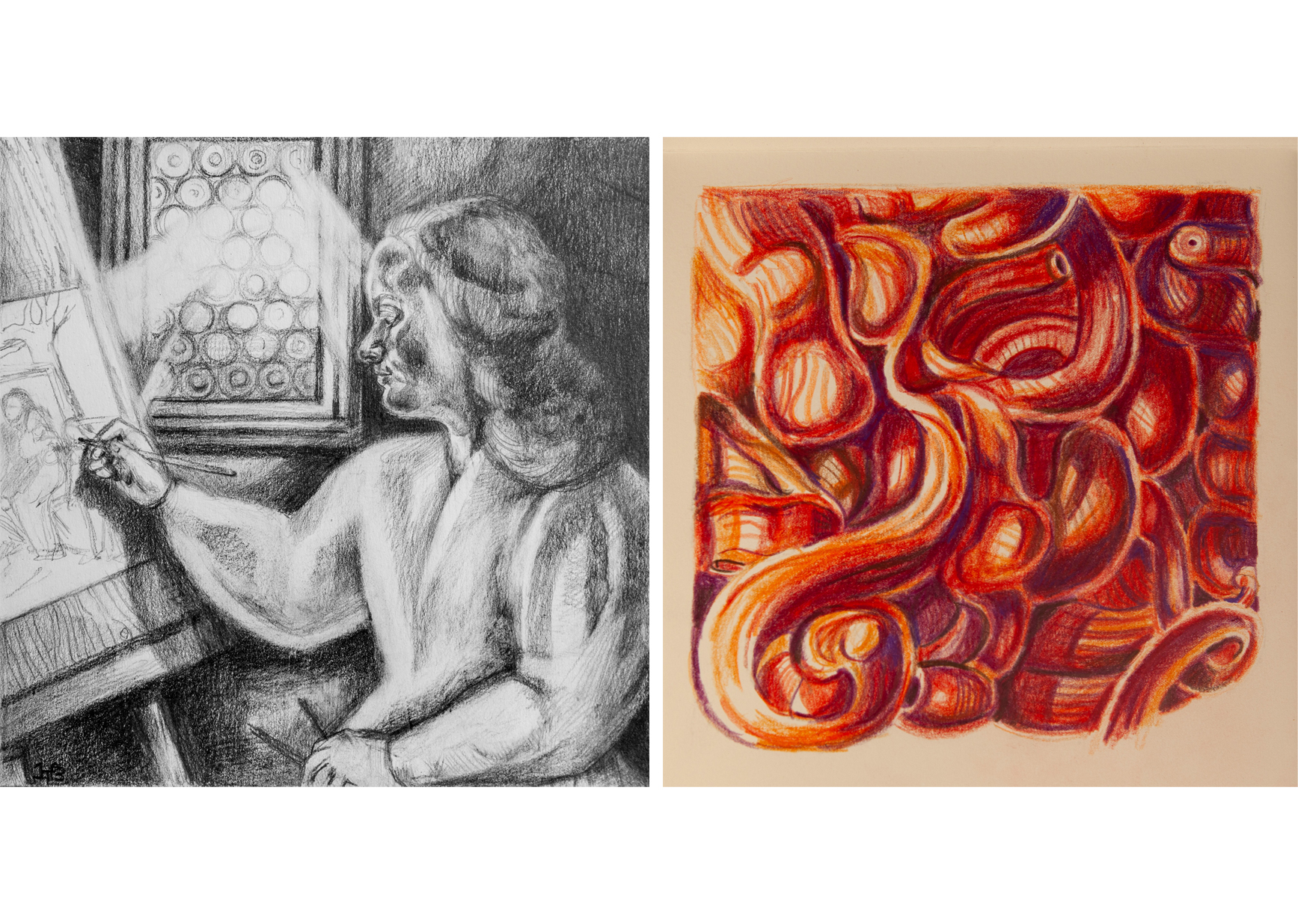These two drawings are by Holly Trostle Brigham, part of an artist’s book tracing the life of Pre-Raphaelite muse, model, artist and poet Elizabeth Eleanor Siddal. The book is included in the exhibition,‘I Wake Again’: Holly Trostle Brigham on Elizabeth Siddal on view February 26 – May 29, 2022. Brigham, a Philadelphia based figure painter, recovers and champions the work of accomplished women from history. Her artistic practice combines thorough research, iconographic detail, and vivid imagination to re-present stories erased by the patriarchal past. In this exhibition, Brigham turns her eye to Elizabeth Eleanor Siddal (1829-1862). Known today as a muse to Pre-Raphaelite artists, Siddal in fact created a significant body of visual and written work herself.
Brigham’s book includes poetry by Kim Bridgeford, which I found particularly compelling as I considered Siddal’s all too brief life. Until recently, Siddal’s life story has been reduced to a sexualized fixation with her brilliant red hair. In the poem “Autumn,” Bridgeford insightfully captures the burden of emotional and creative erasure which Siddal’s hair placed upon her both during and after her lifetime:
You take a feature: it is here
In a glimpse of bright red hair.
It could be something else, of course:
But in this read, it is the purse
That makes the story what it is.
Hair like this can make a business.
You don’t want to think that this is true:
You would like the truth to be of you,
Your talent, and you’re this and that.
Instead, the truth is random, but
We make the most of what is what.
It’s always been that way. The random
Is re-made to what is seldom
Talked about: the curl of autumn.
Siddal’s desire to become an artist pre-dated her association with the young Pre-Raphaelite Brotherhood members, a fact that has been historically overlooked, along with the visual and written work she created during her lifetime. Once she began modeling, first for Walter Deverell’s Twelfth Night followed infamously by John Everett Millais’s Ophelia, it was Siddal’s hair, not her talent by which she was judged.
These two images by Holly Trostle Brigham capture the dichotomy between Siddal’s identity as an artist and how the world saw her. Creation shows a young Siddal at work on a drawing adhered to an easel placed before her. The composition of the drawing resembles Siddal’s own painting Madonna and Child with Angel. To the right, light streams in through a bottle glass window, a familiar detail of Pre-Raphaelite compositions. The second drawing, Resurrection, the only color image in Brigham’s book, is an expanded detail of Siddal’s hair. Red curls fill the picture plane, successfully obliterating any trace of the individual whose head it adorns.
The historic erasure of the individual, and of female creativity, is not unique to Siddal. The patriarchal nature of western culture has systemically omitted the contributions of women, artistic or otherwise. At the Delaware Art Museum, we are committed to acquiring new works and displaying special exhibitions featuring women artists and widening the stories we tell with art to build a more inclusive Museum.
Margaretta S Frederick
Annette Woolard-Provine Curator, Bancroft Pre-Raphaelite Collection
Join an upcoming Artist Talk at the Museum or a Virtual Art Chat to hear Holly Trostle Brigham speak about her images of Elizabeth Siddal.
Left to right: Elizabeth Siddal at Her Easel, 2020. Holly Trostle Brigham (born 1965). Graphite on paper, 8 x 8 inches. Courtesy of the artist. © Holly Trostle Brigham. | Resurrection no. 12B in Elizabeth Siddal: ‘I Wake Again’, 2020. Holly Trostle Brigham (born 1965). Colored pencil on book paper, page: 8 x 8 inches, book: 9 1/8 × 8 3/4 inches. Courtesy of the artist. © Holly Trostle Brigham.

